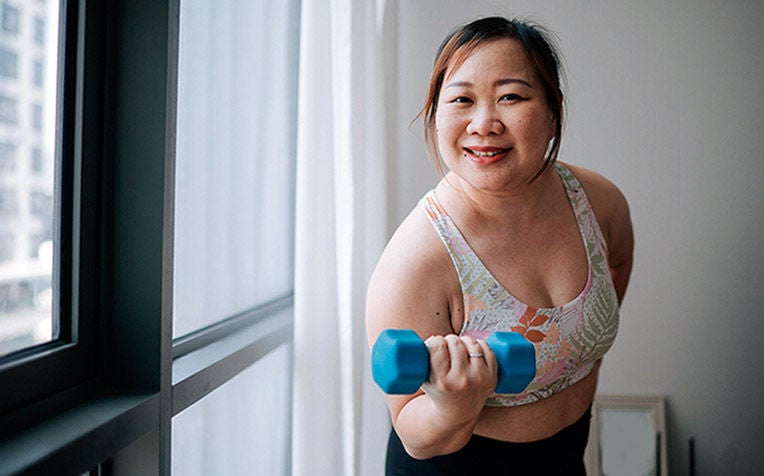
To strengthen bones and build bone health , do a combination of muscle strengthening exercises, weight-bearing and balance exercises.
When it comes to exercises for building strong bones, quality is better than quantity.
"Do a combination of recommended exercises to reap their full benefits," shares Senior Physiotherapist Phoebe Ting from the Department of Physiotherapy at Sengkang General Hospital (SKH), a member of the SingHealth group.
"These exercises work all the major muscle groups including the legs, hips, back, abdomen, chest, arms and shoulders," she adds.
Remember that quality of movement is also more important than quantity — doing more repetitions may not always be better.
See a physiotherapist for advice on the type of exercises to do and how to make them manageable and effective for you.
/elderly-exercise-illustration.jpg)
3 Exercises for building strong bones and bone health
1. Muscle strengthening: Weight lifting and exercise bands
How these exercises help:
Your muscles control and support your joints. These exercises enable your muscle tendons to pull on the bones, while the body responds by building more bone which boosts bone strength as a result. It can also help provide pain relief for osteoporosis patients.
2. Weight-bearing: Stair climbing, brisk walking, sit to stands, squats
How these exercises help:
The body responds to these by increasing the density of your bones. Trunk and core strengthening such as planks are advisable to give support to the spine — a common place for osteoporotic fractures.
3. Balance exercises: Tai chi, pilates or classes with a lot of movement involved
How these exercises help:
Improves your balance and reaction time to prevent falls and reduces the risk of fractures as a result of a fall. It is important that these are done correctly, preferably under guidance of a trained instructor who is aware of your condition.
Exercises that may not be suitable for people with osteoporosis
Sit-ups (crunches) and excessive bending at the waist.
Twisting movements such as in golf.
Explosive exercises or high impact like jumping, or contact sports.
With appropriate rehabilitation, exercise training can improve strength, balance, and function when recovering from an injury.
Osteoporosis in Singapore
Osteoporosis (or brittle bones) increases the risk of fractures, which can lead to longer hospitalisations, serious health problems, affects mobility and even disability.
In Singapore, hip fracture hospital admissions in 2020 have increased to 2,729 cases, compared to 1,487 in 2017. This number is projected to hit 9,000 by 2050 due to our ageing population.
Osteoporosis often progresses without symptoms or pain until a bone fracture occurs. Dr Donovan Tay, Senior Consultant in Endocrinology from the Department of General Medicine at SKH shares, "Up to 50% of patients with fractures didn't know they had osteoporosis prior to suffering an injury."
Post-menopausal women over the age of 65 and men above 70 are more likely to develop osteoporosis. Hence Dr Tay suggests osteoporosis screening for women above 65 and men above 70, or earlier at 50 if you are at greater risk.
Osteoporosis fracture facts that will shock you to your bones
"When you get an osteoporotic fracture (the medical term for an osteoporosis fracture), it can be life-changing. Your quality of life decreases and it affects your ability to do everyday things. Recovery also takes a long time; you'll be unable to work and have to worry about healthcare costs," adds Dr Colin Wang, Associate Consultant from the Department of Orthopaedic Surgery at SKH.
Here are some startling facts:
Globally, 1 in 3 adults above 65 years old suffers a fall.
26% of elderly patients who broke their hip die within one year.
2 in 3 adults aged 60 and above have 'fall phobia' (after a fall), which can lead to withdrawal from physical or social activities.
Prolonged immobility and inactivity will increase social isolation and loneliness, risk of heart diseases, gradual muscle loss (sarcopenia) and rapid deconditioning which make the elderly even more prone to falling and sustaining fractures.
For spinal injuries, nerve damage may result and in worse cases, patients become permanently wheelchair-bound and need help with basic activities like eating, dressing or personal hygiene.
Even when nerve injuries do not occur, fractures can lead to permanent deformity, chronic pain and joint stiffness.
This article was adapted from Skoop magazine (issue 9).
Ref: J22
Check out other articles on bone health:
Osteoporosis: What Women Need to Know About Bone Health
Arthritis: What Is It and Types
Contributed by


















 Get it on Google Play
Get it on Google Play